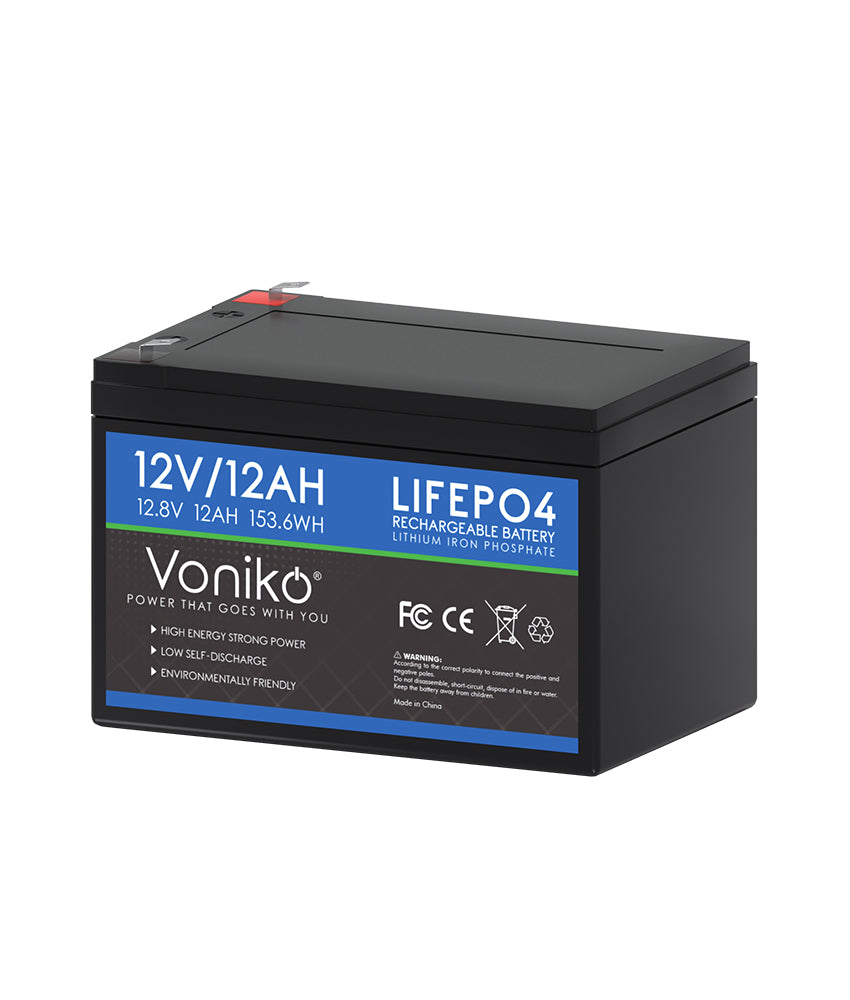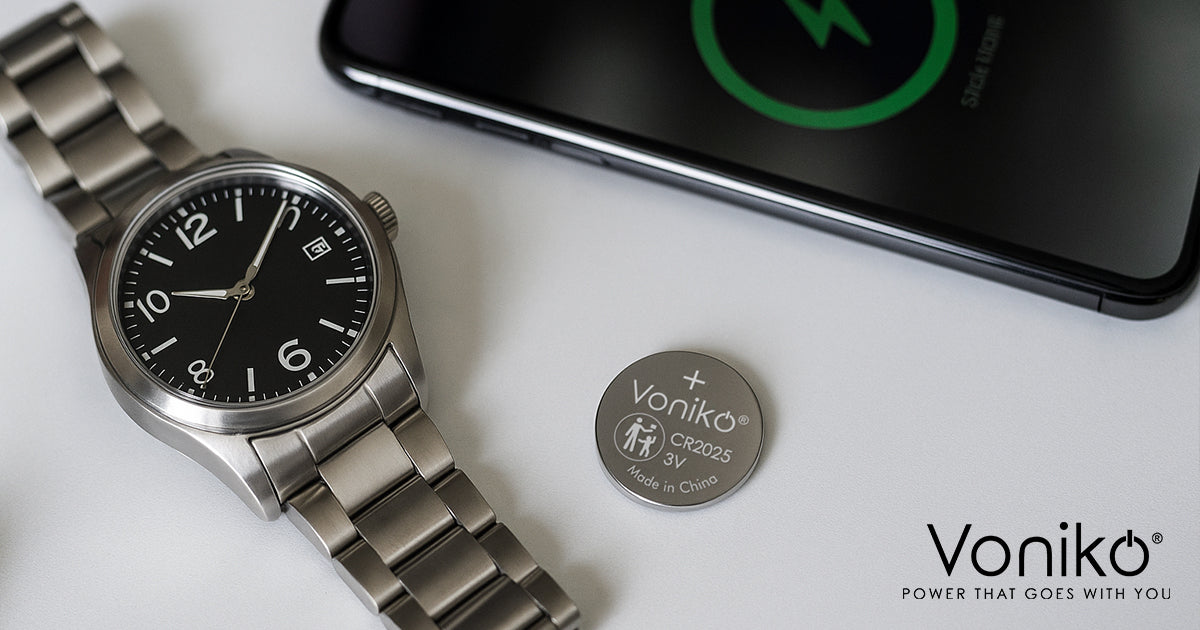Nothing's more frustrating than checking your Blink camera app only to discover your security camera died hours ago, right when you needed it most. Whether it's missing a package delivery or failing to capture important security footage, dead batteries can leave your home vulnerable when you least expect it.
Blink cameras have revolutionized home security with their wireless convenience and easy installation, but they're only as reliable as the batteries that power them. Unlike hardwired security systems, your Blink cameras depend entirely on battery power to keep watching over your property. When those batteries fail, your security coverage disappears until you notice and replace them.
At Voniko, we've powered thousands of security cameras with our premium battery solutions, and we understand exactly what it takes to keep Blink cameras running reliably. Whether you need dependable AA batteries for everyday use or want to upgrade to lithium options for maximum performance, choosing the right replacement batteries ensures your security system never lets you down.
Blink Camera Battery Requirements
Most Blink camera models use two AA batteries, though it's always worth checking your specific model since requirements can vary between generations. The Blink Indoor, Outdoor, XT, and XT2 cameras typically rely on standard AA cells, while some newer models might have different specifications or battery configurations.
Blink cameras are designed to be energy efficient, using advanced power management to extend battery life between replacements. They only wake up when motion is detected or when you access them remotely, which helps conserve power during quiet periods. However, this efficiency depends heavily on using quality batteries that can deliver consistent power throughout their discharge cycle.
The power demands of Blink cameras vary significantly based on usage patterns and environmental conditions. Recording video, streaming live feeds, maintaining Wi-Fi connections, and operating in extreme temperatures all affect how quickly batteries drain. Understanding these factors helps you choose the right battery type and plan replacement schedules.
Key factors affecting Blink camera battery performance:
- Recording frequency: More motion triggers mean faster battery drain
- Live view usage: Streaming video consumes significant power
- Wi-Fi signal strength: Weak signals force cameras to work harder
- Temperature extremes: Cold weather dramatically reduces battery capacity
- Camera features: Night vision, two-way audio, and notifications all use power
Quality batteries make a huge difference in Blink camera performance. Cheap batteries might seem like a bargain, but they often fail prematurely, provide inconsistent voltage, or perform poorly in challenging conditions – exactly when you need your security cameras most.
Why Alkaline Batteries Often Disappoint in Blink Cameras
Many Blink camera owners start with alkaline batteries because they're widely available and seem like the obvious choice. However, alkaline batteries have several limitations that make them less than ideal for security cameras, especially those installed outdoors or in demanding environments.
The biggest problem with alkaline batteries in Blink cameras is their poor cold weather performance. Temperature drops dramatically affect alkaline battery capacity, with performance declining by 20-50% when temperatures fall below freezing. Since many Blink cameras are installed outdoors to monitor entry points and property perimeters, cold weather failures can leave you without security coverage during winter months.
Alkaline batteries also struggle with the power demands of modern security cameras. While Blink cameras are energy efficient, they still need periodic bursts of power for recording, transmitting data, and maintaining connectivity. As alkaline batteries age, their internal resistance increases, making it harder to deliver these power bursts effectively.
Common alkaline battery problems in Blink cameras:
- Cold weather failures: Dramatic capacity loss below 32°F
- Voltage instability: Performance drops as batteries discharge
- Shorter lifespan: Frequent replacement needs, especially in high-usage cameras
- Inconsistent performance: Gradual decline in reliability over time
- Potential leakage: Risk of corrosive damage to expensive camera electronics
While alkaline batteries might work adequately for indoor cameras in controlled environments, they're generally not the best choice for outdoor Blink cameras that face temperature extremes and demanding operating conditions.
The Lithium Battery for Security Cameras
Lithium batteries are hands down the best choice for Blink cameras, offering superior performance, longer life, and better reliability than any other battery type. Once you experience the difference lithium batteries make, you'll never want to go back to alkaline.
The most impressive advantage of lithium batteries is their exceptional cold weather performance. While alkaline batteries struggle in freezing temperatures, lithium batteries maintain consistent power output even in extreme cold. This reliability is crucial for outdoor security cameras that need to function year-round regardless of weather conditions.
Lithium batteries also provide much more stable voltage throughout their discharge cycle. This consistent power delivery ensures your Blink cameras operate reliably from the first day you install fresh batteries until they need replacement. You won't experience the gradual performance degradation that's common with alkaline batteries as they age.
Why lithium batteries excel in Blink cameras:
- Extended lifespan: 2-4 times longer than alkaline in security camera applications
- Cold weather reliability: Consistent performance down to -40°F
- Stable voltage output: Steady power prevents camera malfunctions
- High current capability: Handles power bursts for recording and transmission
- Low self-discharge: Maintains charge during low-activity periods
The longer lifespan of lithium batteries also means fewer battery changes, reducing maintenance hassle and the risk of security gaps from dead cameras. When you factor in the extended life and superior reliability, lithium batteries often cost less per year than constantly replacing alkaline batteries.
Battery Life Expectations for Different Blink Models
Battery life in Blink cameras varies considerably depending on the specific model, installation location, and usage patterns. Most users can expect 1-2 years of service from quality lithium batteries under normal residential use, though actual performance depends on several key factors.
Blink Indoor cameras typically achieve the longest battery life since they operate in controlled temperature environments and often have less motion trigger activity than outdoor cameras. These cameras might run for 2+ years on premium lithium batteries if placed in low-traffic areas with moderate usage patterns.
Outdoor Blink cameras face more challenging conditions that can reduce battery life significantly. Temperature extremes, frequent motion triggers from passing cars or pedestrians, and exposure to weather all contribute to faster battery drain. Even so, quality lithium batteries usually provide 3-6 months of reliable service in outdoor installations.
Typical battery life by usage scenario:
- Low activity indoor cameras: 2 years with lithium batteries
- Moderate activity indoor cameras: 8-16 months with lithium batteries
- Low activity outdoor cameras: 8-16 months with lithium batteries
- High activity outdoor cameras: 4-8 months with lithium batteries
- Extreme usage scenarios: 3 months even with premium batteries
Remember that these are general estimates, and your actual results may vary based on specific conditions. Cameras monitoring busy driveways or high-traffic areas will drain batteries much faster than those watching quiet side yards or storage areas.
Temperature Impact on Blink Camera Battery Performance
Temperature is one of the most critical factors affecting Blink camera battery performance, yet it's often overlooked when planning security camera installations. Understanding temperature effects helps you choose the right batteries and set realistic expectations for battery life.
Cold weather is particularly brutal on battery performance. When temperatures drop below freezing, the chemical reactions inside batteries slow down significantly, reducing their ability to deliver power. This is especially problematic for security cameras that need reliable operation regardless of weather conditions.
Extreme heat also affects battery performance, though usually not as dramatically as cold. High temperatures can accelerate battery self-discharge and potentially cause reliability issues. Cameras installed in direct sunlight or enclosed spaces that heat up significantly may experience reduced battery life during hot summer months.
Temperature effects on different battery types:
- Alkaline at 32°F: 20-30% capacity loss
- Alkaline at 0°F: 50%+ capacity loss, possible complete failure
- Lithium at 32°F: Minimal capacity loss
- Lithium at 0°F: 10-20% capacity loss, still functional
- Both types above 100°F: Accelerated self-discharge, reduced lifespan
This temperature sensitivity is why premium lithium batteries are essential for outdoor Blink cameras in climates with harsh winters or extremely hot summers. The consistent performance across temperature ranges ensures your security coverage doesn't disappear when weather conditions become challenging.
Signs Your Blink Camera Batteries Need Replacement
Don't wait for your Blink cameras to completely die before replacing batteries. Most cameras provide several warning signs that batteries are getting weak, and catching these early prevents security gaps and ensures continuous monitoring of your property.
The most obvious indicator is the low battery notification in your Blink app. When batteries drop to about 20% capacity, you'll receive alerts on your smartphone. Don't ignore these warnings – batteries can fail quickly once they reach this threshold, especially in cold weather or high-usage situations.
Performance degradation often appears before you get low battery alerts. Watch for delayed motion detection, shorter recording times, poor video quality, or connection problems. These issues can indicate insufficient battery power even when the app doesn't show critically low battery levels.
Early warning signs of weak batteries:
- Low battery notifications: App alerts when capacity drops below 20%
- Delayed motion detection: Camera takes longer to trigger recordings
- Shortened video clips: Recordings stop before reaching your set duration
- Connectivity issues: Frequent disconnections from Wi-Fi or sync module
- Poor video quality: Reduced resolution or frame rate in recordings
- Missed notifications: Delayed or missing motion alerts
Some users notice that cameras become less sensitive to motion as batteries weaken, missing events that would normally trigger recordings. If your camera seems to be missing activity it used to catch reliably, weak batteries might be reducing its sensitivity and performance.
Choosing the Right Battery Brand for Blink Cameras
Not all AA batteries are created equal, especially when it comes to high-performance applications like security cameras. The battery brand you choose can significantly impact your Blink camera's reliability, longevity, and overall performance.
Quality matters more than price when it comes to security camera batteries. Cheap batteries from unknown manufacturers often fail prematurely, provide inconsistent power, or leak and damage expensive camera electronics. For devices as important as security cameras, investing in reputable battery brands is essential.
At Voniko, our AA lithium batteries are specifically engineered for high-performance devices like security cameras. Our SCM (Super Conducting Material) Technology ensures consistent power delivery throughout the battery's entire lifespan, while our POWER LOCK technology prevents self-discharge during storage.
What to look for in Blink camera batteries:
- Proven cold weather performance: Essential for outdoor cameras
- Long shelf life: Batteries maintain charge during storage
- Consistent voltage output: Prevents performance drops as batteries age
- Leak-proof construction: Protects expensive camera electronics
- High capacity: More stored energy means longer runtime
Avoid bargain-brand batteries or "heavy duty" alkaline options for your security cameras. These might work fine for low-drain devices like TV remotes, but they're not designed for the demanding power requirements and reliability needs of modern security systems.
Installation Tips for Maximum Battery Life
Proper battery installation and camera setup can significantly extend battery life and improve overall system reliability. These simple tips cost nothing but can add months to the time between battery replacements.
Always use batteries of the same brand and type in both battery slots, and replace both batteries at the same time. Mixing different battery types or brands creates uneven discharge patterns that can reduce performance and lifespan. Even if one battery seems fine, replace both together for optimal results.
Before installing new batteries, clean the battery contacts in your camera with a dry cloth to remove any corrosion or residue from old batteries. Poor contact between batteries and terminals increases resistance, which reduces efficiency and can cause premature failure.
Battery installation best practices:
- Use matching batteries: Same brand, type, and preferably from the same package
- Replace both batteries together: Don't mix old and new batteries
- Clean contacts: Remove any corrosion for optimal electrical connection
- Check orientation: Verify positive and negative alignment before closing compartment
- Test camera operation: Confirm everything works properly after installation
Store spare batteries in a cool, dry place away from metal objects. Quality batteries like our Voniko lithium options have excellent shelf life, so you can stock up during sales without worrying about deterioration during storage.
Optimizing Blink Camera Settings for Battery Life
While choosing the right batteries is crucial, optimizing your camera settings can dramatically extend battery life without sacrificing security coverage. Most Blink cameras offer several adjustable settings that affect power consumption, and finding the right balance saves battery life.
Motion sensitivity settings have a huge impact on battery drain. If your camera triggers too frequently from minor movements like swaying branches or passing shadows, it's wasting battery power on unnecessary recordings. Adjust sensitivity levels and create motion zones to focus only on areas where you actually want alerts.
Video recording length also affects battery consumption. Shorter clips use less power, so consider whether you really need 60-second recordings or if 10-30 seconds would capture the important information while conserving battery life.
Settings that affect battery life:
- Motion sensitivity: Lower sensitivity reduces false triggers
- Recording length: Shorter clips conserve battery power
- Motion zones: Focus detection on specific areas only
- Live view usage: Minimize unnecessary streaming
- Two-way audio: Use sparingly as it drains batteries quickly
Temperature-controlled camera placement can also help extend battery life. If possible, install outdoor cameras in shaded areas or use protective housings to shield them from extreme temperatures. Even a few degrees of temperature protection can make a noticeable difference in battery longevity.
Cost Analysis: Premium vs. Budget Battery Options
When it comes to powering your security cameras, the cheapest batteries are rarely the most economical choice. While premium batteries cost more upfront, their superior performance and longer lifespan often make them significantly more cost-effective over time.
Let's look at real-world costs over a two-year period. Budget alkaline batteries might cost 25 but last 3 months. Over 1 years, you'd spend 34 on lithium batteries, but you'd change batteries four times instead of twice.
However, cost isn't just about money – it's also about security coverage and convenience. Cheap batteries are more likely to fail unexpectedly, potentially leaving your home unprotected during critical times. They're also more prone to performance issues and leakage that can damage expensive camera electronics.
Total cost comparison over 1 years:
- Budget alkaline: $32 in batteries, 24 replacement cycles, unreliable performance
- Premium alkaline: $40 in batteries, 3 replacement cycles, better reliability
- Voniko lithium: $60 in batteries, 1-2 replacement cycles, maximum reliability
Factor in the value of your time, the inconvenience of frequent battery changes, and the potential security risks of camera failures when making your battery choice. The peace of mind that comes with reliable batteries is often worth the modest price difference.
Battery-Related Blink Camera Issues
Even with quality batteries, Blink cameras can sometimes experience power-related problems. Understanding how to diagnose and resolve these issues can save you time and prevent unnecessary battery waste or service calls.
If your camera suddenly stops working, don't automatically assume the batteries are dead. Check the battery level in your Blink app first, and try accessing the camera remotely to see if it responds. Sometimes connectivity issues or software glitches can mimic battery problems.
Rapid battery drain often indicates configuration issues rather than battery defects. Check your motion sensitivity settings, recording frequency, and Wi-Fi signal strength. Cameras that struggle to maintain connectivity work much harder and drain batteries faster than those with strong, stable connections.
Common battery-related problems and solutions:
- Rapid battery drain: Check motion sensitivity and Wi-Fi signal strength
- Intermittent operation: Clean battery contacts and ensure proper installation
- Shortened battery life: Review camera settings and usage patterns
- Connectivity issues: May indicate weak batteries even before low battery alerts
- Recording failures: Often caused by insufficient battery power during high-demand operations
If you experience consistent battery problems across multiple cameras, consider environmental factors like extreme temperatures, high activity levels, or poor Wi-Fi coverage that might be affecting all cameras in your system.
Planning Your Battery Replacement Strategy
Successful Blink camera operation requires proactive battery management rather than reactive replacement when cameras fail. Developing a replacement strategy ensures continuous security coverage and reduces the risk of cameras going offline at critical moments.
Consider replacing batteries on a schedule rather than waiting for low battery alerts. Many users find that replacing batteries every 12-18 months provides reliable service while avoiding unexpected failures. Mark calendar dates for battery checks and replacements to stay ahead of potential problems.
Stock up on batteries during sales or when buying in bulk to reduce per-unit costs. Quality batteries like our Voniko lithium options have excellent shelf life, so you can buy a year's supply without worrying about deterioration during storage.
Effective battery management strategies:
- Scheduled replacement: Replace batteries before they fail completely
- Bulk purchasing: Buy batteries in quantity for better pricing
- Spare battery rotation: Keep fresh batteries on hand for immediate replacement
- Usage monitoring: Track which cameras drain batteries fastest
- Seasonal adjustments: Plan for increased drain during extreme weather periods
Keep detailed records of battery installation dates and performance for each camera. This information helps you identify cameras that consistently drain batteries faster, which might indicate placement issues, configuration problems, or the need for different battery types.
Your home security system is only as reliable as the batteries that power it. Whether you choose our premium lithium batteries for maximum performance or high-quality alkaline options for budget-conscious installations, investing in quality replacement batteries ensures your Blink cameras provide the reliable security coverage your family deserves. Don't let dead batteries compromise your home's protection – choose batteries that keep your security system running strong year-round.




















